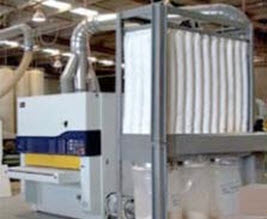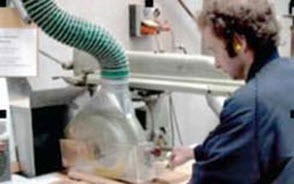Wood Dust - Health Hazards and Control: Fact Sheet
This guidance note provides advice on minimising the risk to health from exposure to wood dust when handling and working with natural and manufactured (fibre-or particle board, like MDF) wood - Wood Dust - Health Hazards and Control: Fact Sheet
Purpose
Both the assessment and the consideration of control options are best carried out in consultation with relevant workers and any health and safety representatives (HSRs).
Manufacturers, importers and suppliers of wood have an obligation under the Work Health and Safety Act 2011 to provide health and safety information so it can be used safely and without risk to health.
Background
The manufacture of wood products often results in the generation of fine airborne wood particles and dust. Typical wood-working activities that produce dust are machining operations (eg sawing, routing, turning) and hand or machine sanding.
Other sources of breathable wood dust are when bagging of dust from local exhaust ventilation (LEV) systems, using compressed air to blow dust off articles and dry sweeping of factory floors.
Formaldehyde is used in the production of manufactured wood such as MDF. When first made the unsealed surface of the boards may release some formaldehyde gas, but this quickly dissipates during initial storage.
Air monitoring results confirm that when manufactured wood products are cut or sanded, the only significant airborne hazard is exposure to wood dust. Provided that the wood dust is adequately controlled using LEV then exposure to all other airborne hazards (including formaldehyde) is negligible.
Health hazards
Reported health effects associated with exposure to dust from wood products include:
- skin disorders such as allergic dermatitis – certain timbers are known to produce adverse health effects and sensitisation (see: Further information for a Health and Safety Executive, UK, information sheet on toxic woods)
- asthma and impaired lung function
- nose irritation, rhinitis (runny nose), violent sneezing, blocked nose and nose bleeds
- throat irritation, and sore and watering eyes
A rare type of nasal cancer has also been reported in people who have worked with hard woods in very dusty wood-working environments with little or no dust control in place.
Managing the risks
1. Alternative woods
Suppliers of wood and speciality timbers should provide information, eg a safety data sheet (SDS), about any potential health effects of the wood being used. Employers should consider using woods that have similar strength or decorative effects but are less hazardous.
2. Controlling the build-up of wood dust
The total elimination of wood dust from a wood-working environment is not usually practicable, however, the health risk associated with exposure to dust from wood products can be minimised through:
- work processes that produce minimum dust, eg using a plane rather than a sander
- ensuring all dust producing processes are fitted with local exhaust ventilation
3. Local exhaust ventilation system
LEV is the standard industry practice. The following points may assist when reviewing its design and effectiveness:
- avoid long lengths of flexible ducting that can be easily damaged
- cap or close any unused openings or branches to maximise dust capture
- do not use open ducts to try to capture the dust as it is generated, this is ineffective
- keep hard ducting short and simple, avoid right angle bends

4. Monitoring dust levels
If you are uncertain about health risks, you may need personal air monitoring to regularly assess the levels of exposure. National Exposure Standards have been determined for hard woods and soft woods (see: Further information, SafeWork Australia).
5. Preventative maintenance
Plant and equipment should be kept in good condition and the LEV system maintained to work effectively. Establish a maintenance and repair program that includes regular:
- checks for damage to ducting and dust collectors (also known as bag/sock filters)
- replacing or emptying waste collection bags
- inspecting ductwork and fans for dust build up
- inspecting fans for unusual noise or vibration indicating a problem
- (annual) overhaul of the LEV system by a competent person
Records of inspections, repair and maintenance should be recorded as part of the program, for the life of the LEV.
6. Housekeeping
Simple changes to work practices can minimise the level of wood dust in the workplace, for example:
- regularly cleaning or emptying dust collection equipment
- using methods for cleaning up such as damping down before sweeping, or using an industrial vacuum cleaner fitted with a HEPA filter
- implementing a ‘clean up as you go’ policy
- do not use compressed air to clear work benches or to blow dust off wood products except for inaccessible areas of plant
- do not use compressed air to remove dust from skin or clothing

7. Providing respiratory protective equipment
When other dust control measures are not practicable, a respiratory protective device (RPD) suitable for particulates should be worn (it must be at least a Class P1 respirator). Australian/New Zealand Standard AS/NZS 1715 provides comprehensive guidance on how to select the correct RPD. Ensure that the equipment meets an appropriate standard. Look for Australian Standard markings (see AS/NZS 1716) or equivalent on the respirator or its container.
8. Other safety measures
- Obtain health and safety information from the wood supplier or manufacturer (the MSDS) and make it readily accessible
- Inform workers on the hazards and risks associated with exposure to wood dust
- Train workers on the correct use of workplace control measures
- Supervise workers to ensure that the adopted control measures are being used correctly
Reduce the chance of dust explosion by keeping ignition sources such as flame and sparks away from areas where dust is being generated.
Regulations/legal responsibilities
Employers have a duty of care under the Work Health and Safety Act 2011 to ensure, so far as is reasonably practicable, that the working environment is safe and without risks to health for workers and others.
Acts and regulations
Wood dust
Section 19 and Division 7 WHS Act
WHS Regulation Managing Risks from Airborne Contaminants
PPE
Section 19 WHS Act Clause 44 WHS Regulation
Standards Australia
AS 3640:2004, Workplace atmospheres – Method for sampling and gravimetric determination of inhalable dust
AS/NZS 1715, Selection, use and maintenance of respiratory protective devices
AS/NZS 1716, Respiratory protective devices
Further information
The NSW Government released its Dust Strategy 2020-2022 to help reduce the impact of dust diseases on workers.
SafeWork Assistance Service 13 10 50
SafeWork Australia (SWA) – safeworkaustralia.gov.au
Technical data and OHS information including National Exposure Standards through the Hazardous Substances Information System (HSIS)
Health and Safety Executive (UK) – hse.gov.uk
Wordworking Sheet No. 30 – Toxic Woods hse.gov.uk/pubns/woodindx.htm
Hazard Assessment Document EH75/1 – Medium density fibreboard
SW08419 0816